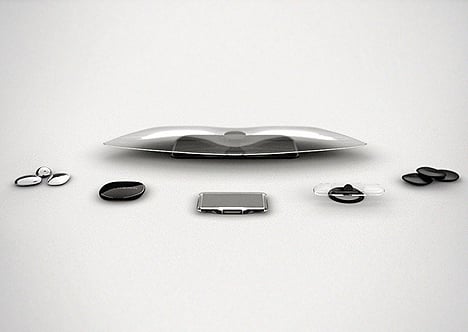Modular computing isn’t anything new. Designers have been toying with the idea for years but the Stream concept is unique in packaging the whole experience in a form more conducive to zen relaxation creating a stronger relationship with the user. The Stream concept consists of Experience Modules, the Core Component, Component Modules, a Display, Charging Cradle, and Charging Base.
Each part is wirelessly connected through various technologies, giving them greater flexibility whether carried in the pocket or arranged on the Charging Base – much more beautiful to look at than even the most beautiful products Cupertino can pump out.
It can seem like a complex system so lets break down what each one does:
- The Experience modules contain a solid state drive to store all your files and programs, as well as a logic board which handles all the wireless connections to other modules. Each “river stone” represents either Media (music, movies, tv etc.), Memories (personal photos, videos etc.), Connections (VOIP, internet browser, social networking etc.), Documents, Creations (Photoshop, 3D etc) or Games.
- The Core module is the primary processing unit, capable of performing all tasks to some extent, but mainly designed for basic on-the-go tasks that a smartphone would do.
- The Component modules enhance the processing power of the system – by adding extra RAM, processing and/or graphics power
- The Portable Display is self explanatory. It uses a new UI called Locus (location based interface) which basically means the display knows where you are, what you’re doing and how you’re using it so the UI adapts to better suit it. However the system can connect to any size screen and the interface will dynamically scale to the correct size.
- The Charging Cradle wirelessly keeps the 4.3 Portable Display module(s) juiced.
- The Charging Base which is designed to sit in a central location and gives everything juice via wireless charging – a technology pioneered by Powercast. It also backs up all your data and allows for in-air interaction with the interface through, say, a tv.
Lets make up a scenario to better illustrate the idea. Say I go to the store to purchase Stream but I am only looking for basic email, web, game, and mobile phone capabilities. I pick up the required pieces which are the the Connections module which features email, internet and VOIP services as well as the Core Component. I may also purchase the Charging Base to keep everything charged and organized, as well as a compatible display. I take it all home and artfully arrange everything so it looks good on a desk I no doubt purchased to accent my new rock garden. I later decide I want to do some gaming. I will need a more powerful computer and the software for gameplay so it’s back to the store, only this time I don’t have to chuck the whole thing – all I need to do is purchase the Games module and some extra RAM and CPUs (Component Modules). I grab my Core Component, Connections rock and my Media rock (for music on the road trip) and my display to interact with everything – perhaps the GPS system to find the fastest route back to the store. The story can go on and on but I’m sure you get the gist.
There’s a slight disconnect though because in time your desk could be overflowing with rocks. However it’s the idea of purely envisioning our future computerlative systems as extensions of our homes, personalities, and needs. It doesn’t necessarily have to be a river rock metaphor. This analogy could exist in almost any form – legos, cubes, stuffed animals and that excites me. Cloud computing be dammed!
Designer: Barton Smith

